This past weekend I travelled to New York to visit my sister, who recently moved to Brooklyn. Anyone would love her neighborhood, fit in in her neighborhood. It’s diverse. From islanders to east asians, there are plenty styles and cultures to observe from afar or experience close up. The hipster coffee shop around the corner is situated between a post office and a caribbean food spot that I am guessing has been there for some time. It is almost as if there were several communities squeezed into one space, all existing harmoniously and at times overlapping in their daily transactions and routines. These communities differ in ethnicity, personal/cultural activity and length of time they’ve been established in Brooklyn.
The machination of gentrification is the means by which this diversity has evolved. While visiting with my sister, at her Brooklyn apartment, the topic of gentrification came up. Her opinion was that
“gentrification [was] inevitable.” Maybe so. Convenience brings new demands. Demands change as time brings new ideals. And so, she sided with supporters of gentrification. They say that the refurbishment of these neighborhoods, once stricken with poverty and high crime rates, are good for everyone, the newcomers and long term residents who are already there. With renovations, come jobs that could provide more income for long time Brooklynites. For newcomers renovations satisfy their more extravagant yuppie needs.
Throughout the discussion I tried to formulate my own opinion about this urban force that was and is currently changing places like Brooklyn and Harlem as well as my hometown, Washington, DC. I said to her, “I understand that gentrification isn’t all bad. But I can not bring myself to say that it is good.” The conversation went on and I  talked. I listened. And finally said, “Here’s my thing. It just seems that people who support gentrification believe that it is good for everyone but a lot of previous residents are displaced by this system. They are bought out of their homes and have to move elsewhere, where the conditions are the same or worse.” So is this system really helping everyone or slowly but surely reversing the demographics: urban poor and wealthy-middle class suburbia turns into well-off city dwellers and the impoverished suburbia?
talked. I listened. And finally said, “Here’s my thing. It just seems that people who support gentrification believe that it is good for everyone but a lot of previous residents are displaced by this system. They are bought out of their homes and have to move elsewhere, where the conditions are the same or worse.” So is this system really helping everyone or slowly but surely reversing the demographics: urban poor and wealthy-middle class suburbia turns into well-off city dwellers and the impoverished suburbia?
In my hometown, Washington, DC it is much easier, most times, for people who own their property to keep their property. Renters, people with reverse mortgages or home owners with bank loans attached to outrageously high interest rates or balloon payments are at risk of being pushed out by higher prices and an inability to pay them. Best case scenario, gentrification and the higher price of living that it brings, may be an incentive for renters or bank loan recipients to do everything possible to keep their homes; and so they progress with the neighborhood. Some long term homeowners are able to resist being bought out and pushed out of the homes and neighborhoods. They are able to avoid their own displacement by keeping up with rising prices, however difficult it may be. Long term homeowners outlast gentrification and bear witness to changes that occur in the neighborhood and keep up with these changes in order to stay put.
 But it would seem that with all this recent refurbishment, renovation and all the jobs created in the process, there would be improvement in the poverty rate in cities with rapid gentrification. In fact, between 2011 and 2012, the rate of poverty in Washington DC went up 2%. In the same amount of time, poverty in New York City ,went up .5% within the year. Although this may not seem like a great deal, in the midst of so much gentrification one would think these are the very numbers that would be improving.
But it would seem that with all this recent refurbishment, renovation and all the jobs created in the process, there would be improvement in the poverty rate in cities with rapid gentrification. In fact, between 2011 and 2012, the rate of poverty in Washington DC went up 2%. In the same amount of time, poverty in New York City ,went up .5% within the year. Although this may not seem like a great deal, in the midst of so much gentrification one would think these are the very numbers that would be improving.
But overall, there is a visible trend of change in urban neighborhoods. There is merit in the desire to improve our district’s urban neighborhoods, but there is also a lack of regard for the people already there, their wants, their needs as citizens. They are ignored and eventually removed, however intentional, or unintentional that may be. This very disregard is what should be improved and revitalized.
Some solutions come to mind. Gentrification itself can be improved if all can participate in it. The way for this to happen is for impoverished communities, inevitably headed towards major renovations and changes should educate themselves about their financial and homeownership capabilities. Meanwhile the community development models that once excluded them, should work towards a new socioeconomic diversity within inner city neighborhoods. The new community model should feature mixed income housing that includes options for lower income, first time buyers and middle income homebuyers. Furthermore, voting is one of the most powerful tools for American citizens. Communities unaware of their voting power are at risk of being manipulated. Voting for representatives who will advocate for their community and individual needs will allow them to have a say in how the community changes. But this is not enough. These communities need to raise their political IQ and understand the decisions being made on their behalf.
In the end, fairness is key. The process of gentrification should remember the old and new residents. My hope is that those who are generally displaced by the system take a more active role in protecting what they have through competition, advocacy and education.


